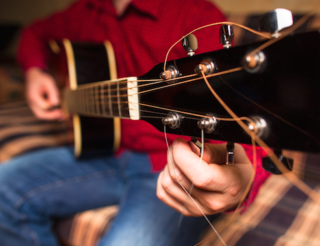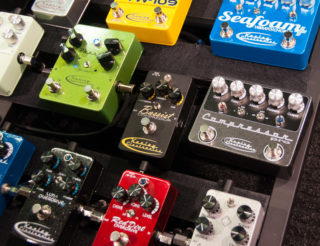Basic Guitar Strumming Patterns
Author: Neelesh Vasistha

It should come as no great surprise that most popular songs are either part or whole rip-offs of famous chord progressions which have been doing the rounds for decades. Not to be too cynical here, but harmonically speaking, really not that much new has been generated since the 70’s.
This begs the following: how are harmonically identical songs made to sound different? Removing ourselves from the trappings of genre and instrumentation, let’s redefine the question: how can we make two songs which use the same chords sound different on the acoustic guitar? The most effective way is the vocal melody. Considering that your average music ‘fan’ pays most attention to the lyrics, the vocal melody can powerfully manipulate the listener’s perception of the song. The second way is with strumming patterns, which is closely linked to rhythm. In this series, the aim is to introduce you to some fundamental strumming patterns.
Even if you don’t plan on being a music theory wizard, you should at least be aware that for most popular music and almost all of rock, there are four beats in a bar. This is represented by the time signature 4/4, which means literally that the song or piece in question contains four quarter note beats. A strumming pattern which features a strum on each beat of the bar would be considered a quarter note rhythm. Listen below:
STRUM QUARTER NOTE
Although these certainly exist in guitar music, they’re rarely employed for the duration of a song. This is because of its trite simplicity and lack of propulsion. Far more commonly seen are songs featuring an 8th note strumming pattern. These include an extra strum in between the beats. A stellar example of this would be the first three chords in the progression ‘Where is my Mind’ by The Pixies:
WHERE IS MY MIND
In practical usage, most songs use a combination of eighth and quarter notes.
While we can open up these elements of music for closer examination, you really shouldn’t let this impinge on your musicality. In almost all circles of musicians I’ve been in or exposed to, strumming patterns are rarely, if ever, talked about, and good strumming comes instead through a mindful ‘feel’ of the rhythm. Don’t be that guy who, when requested to play a song, needs to ask what strumming pattern it uses. You’ll confuse your non-musical friends and your musical friends will be embarrassed.
I’ve heard there are no straight lines in nature, and as an organic expression of creativity, this adage aptly covers music, too. You shouldn’t be coming into musical situation with a roster of preset strumming patterns, but rather a solid and flexible sense of rhythm. Don’t be afraid to deviate from a strumming pattern if you feel the song demands it dynamically or emotionally. You should be able to feel a strumming pattern, that’s the main objective here.








No comments yet - be the first.